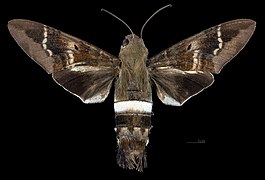
Manduca rustica, the rustic sphinx, is a moth of the family Sphingidae. The species was first described by Johan Christian Fabricius in 1775.

Cocytius antaeus, the giant sphinx, is a moth of the family Sphingidae. The species was first described by Dru Drury in 1773.

Paonias excaecata, the blinded sphinx, is a moth of the family Sphingidae. The species was first described by James Edward Smith in 1797.
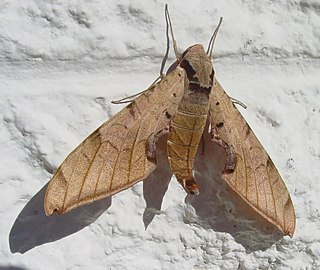
Protambulyx strigilis, the streaked sphinx, is a moth of the family Sphingidae prevalent in the Americas from Florida to Central and South America. The species was first described by Carl Linnaeus in 1771.
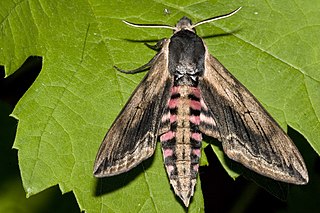
Sphinx ligustri, the privet hawk moth, is a moth found in most of the Palearctic realm. The species was first described by Carl Linnaeus in his 1758 10th edition of Systema Naturae.
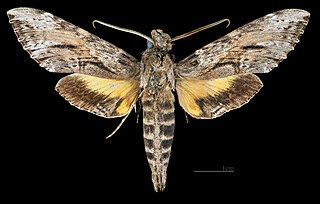
Isognathus rimosa, the rimosus sphinx, is a moth of the family Sphingidae. The species was first described by Augustus Radcliffe Grote in 1865.

Pachylia ficus, known as the fig sphinx, is a moth of the family Sphingidae. It lives from the northern tip of South America in Uruguay through Central America to the southern tip of the United States straying into Arizona and Texas.
Pachysphinx modesta, the modest sphinx or poplar sphinx, is a moth of the family Sphingidae. The species was first described by Thaddeus William Harris in 1839.

Perigonia lusca, the half-blind sphinx or coffee sphinx, is a moth of the family Sphingidae. It was first described by Johan Christian Fabricius in 1777.

Aellopos clavipes, also known as the clavipes sphinx, is a moth of the family Sphingidae.
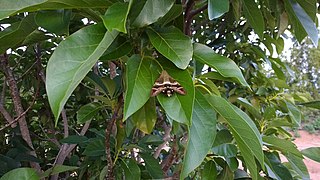
Aellopos fadus, the Fadus sphinx, is a moth of the family Sphingidae. The species was first described by Pieter Cramer in 1776.

Eumorpha anchemolus, the anchemola sphinx moth, is a moth of the family Sphingidae. The species was first described by Pieter Cramer in 1780.

Eumorpha satellitia, the satellite sphinx, is a moth of the family Sphingidae. The family was first described by Carl Linnaeus in 1771. It lives from Brazil and northern Argentina north through Central America, Mexico, and the West Indies to south Texas and southern Arizona.

Eumorpha vitis, known as the vine sphinx, is a moth of the family Sphingidae.
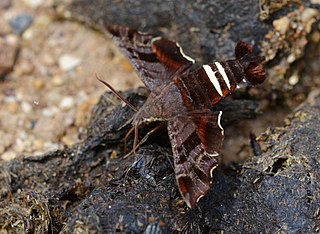
Amphion floridensis, the Nessus sphinx, is a day-flying moth of the family Sphingidae. The species was described by Pieter Cramer in 1777, and renamed in 1920. It is the only member of the genus Amphion erected by Jacob Hübner in 1819. It lives throughout the eastern United States and Canada and occasionally south into Mexico, and is one of the more commonly encountered day-flying moths in the region, easily recognized by the two bright-yellow bands across the abdomen.
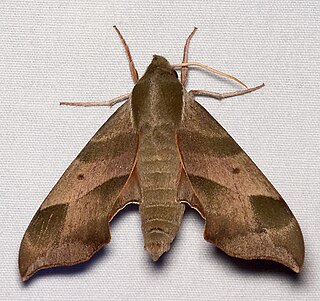
Darapsa myron, the Virginia creeper sphinx, is a moth of the family Sphingidae found in central and eastern North America.

The genus Aellopos consists of large day-flying moths in the family Sphingidae. It was first described by Jacob Hübner in 1819. Species in this genus occur from Maine in the United States through Central America and down to Argentina and Uruguay in South America.

Deidamia inscriptum, the lettered sphinx, is a species of moth of the family Sphingidae. It is the only member of the genus Deidamia. The species was first described by Thaddeus William Harris in 1839 and the genus was erected by James Brackenridge Clemens in 1859.

Sphinx gordius, the apple sphinx, is a moth of the family Sphingidae. The species was first described by Pieter Cramer in 1780.
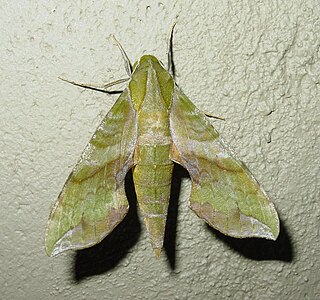
Xylophanes pluto, the Pluto sphinx, is a moth of the family Sphingidae. The species was first described by Johan Christian Fabricius in 1777.



